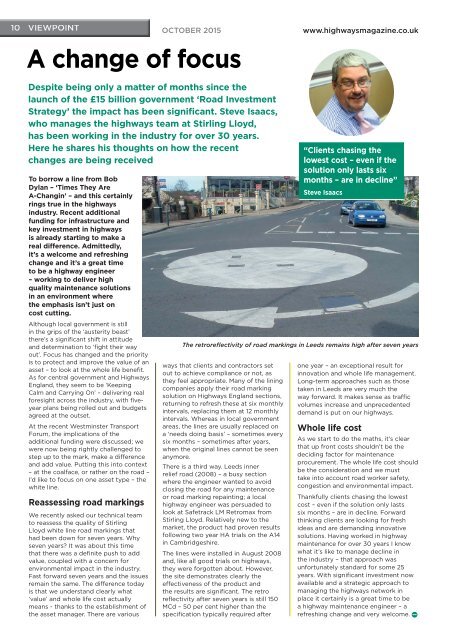Andrew Jones
Highways_October_2015
Highways_October_2015
Create successful ePaper yourself
Turn your PDF publications into a flip-book with our unique Google optimized e-Paper software.
10 VIEWPOINT<br />
OCTOBER 2015<br />
A change of focus<br />
www.highwaysmagazine.co.uk<br />
Despite being only a matter of months since the<br />
launch of the £15 billion government ‘Road Investment<br />
Strategy’ the impact has been significant. Steve Isaacs,<br />
who manages the highways team at Stirling Lloyd,<br />
has been working in the industry for over 30 years.<br />
Here he shares his thoughts on how the recent<br />
changes are being received<br />
To borrow a line from Bob<br />
Dylan – ‘Times They Are<br />
A-Changin’ – and this certainly<br />
rings true in the highways<br />
industry. Recent additional<br />
funding for infrastructure and<br />
key investment in highways<br />
is already starting to make a<br />
real difference. Admittedly,<br />
it’s a welcome and refreshing<br />
change and it’s a great time<br />
to be a highway engineer<br />
– working to deliver high<br />
quality maintenance solutions<br />
in an environment where<br />
the emphasis isn’t just on<br />
cost cutting.<br />
Although local government is still<br />
in the grips of the ‘austerity beast’<br />
there’s a significant shift in attitude<br />
and determination to ‘fight their way<br />
out’. Focus has changed and the priority<br />
is to protect and improve the value of an<br />
asset – to look at the whole life benefit.<br />
As for central government and Highways<br />
England, they seem to be ‘Keeping<br />
Calm and Carrying On’ – delivering real<br />
foresight across the industry, with fiveyear<br />
plans being rolled out and budgets<br />
agreed at the outset.<br />
At the recent Westminster Transport<br />
Forum, the implications of the<br />
additional funding were discussed; we<br />
were now being rightly challenged to<br />
step up to the mark, make a difference<br />
and add value. Putting this into context<br />
– at the coalface, or rather on the road –<br />
I’d like to focus on one asset type – the<br />
white line.<br />
Reassessing road markings<br />
We recently asked our technical team<br />
to reassess the quality of Stirling<br />
Lloyd white line road markings that<br />
had been down for seven years. Why<br />
seven years? It was about this time<br />
that there was a definite push to add<br />
value, coupled with a concern for<br />
environmental impact in the industry.<br />
Fast forward seven years and the issues<br />
remain the same. The difference today<br />
is that we understand clearly what<br />
‘value’ and whole life cost actually<br />
means - thanks to the establishment of<br />
the asset manager. There are various<br />
ways that clients and contractors set<br />
out to achieve compliance or not, as<br />
they feel appropriate. Many of the lining<br />
companies apply their road marking<br />
solution on Highways England sections,<br />
returning to refresh these at six monthly<br />
intervals, replacing them at 12 monthly<br />
intervals. Whereas in local government<br />
areas, the lines are usually replaced on<br />
a ‘needs doing basis’ – sometimes every<br />
six months – sometimes after years,<br />
when the original lines cannot be seen<br />
anymore.<br />
There is a third way. Leeds inner<br />
relief road (2008) – a busy section<br />
where the engineer wanted to avoid<br />
closing the road for any maintenance<br />
or road marking repainting; a local<br />
highway engineer was persuaded to<br />
look at Safetrack LM Retromax from<br />
Stirling Lloyd. Relatively new to the<br />
market, the product had proven results<br />
following two year HA trials on the A14<br />
in Cambridgeshire.<br />
The lines were installed in August 2008<br />
and, like all good trials on highways,<br />
they were forgotten about. However,<br />
the site demonstrates clearly the<br />
effectiveness of the product and<br />
the results are significant. The retro<br />
reflectivity after seven years is still 150<br />
MCd – 50 per cent higher than the<br />
specification typically required after<br />
“Clients chasing the<br />
lowest cost – even if the<br />
solution only lasts six<br />
months – are in decline”<br />
Steve Isaacs<br />
The retroreflectivity of road markings in Leeds remains high after seven years<br />
one year – an exceptional result for<br />
innovation and whole life management.<br />
Long-term approaches such as those<br />
taken in Leeds are very much the<br />
way forward. It makes sense as traffic<br />
volumes increase and unprecedented<br />
demand is put on our highways.<br />
Whole life cost<br />
As we start to do the maths, it’s clear<br />
that up front costs shouldn’t be the<br />
deciding factor for maintenance<br />
procurement. The whole life cost should<br />
be the consideration and we must<br />
take into account road worker safety,<br />
congestion and environmental impact.<br />
Thankfully clients chasing the lowest<br />
cost – even if the solution only lasts<br />
six months – are in decline. Forward<br />
thinking clients are looking for fresh<br />
ideas and are demanding innovative<br />
solutions. Having worked in highway<br />
maintenance for over 30 years I know<br />
what it’s like to manage decline in<br />
the industry – that approach was<br />
unfortunately standard for some 25<br />
years. With significant investment now<br />
available and a strategic approach to<br />
managing the highways network in<br />
place it certainly is a great time to be<br />
a highway maintenance engineer – a<br />
refreshing change and very welcome.



